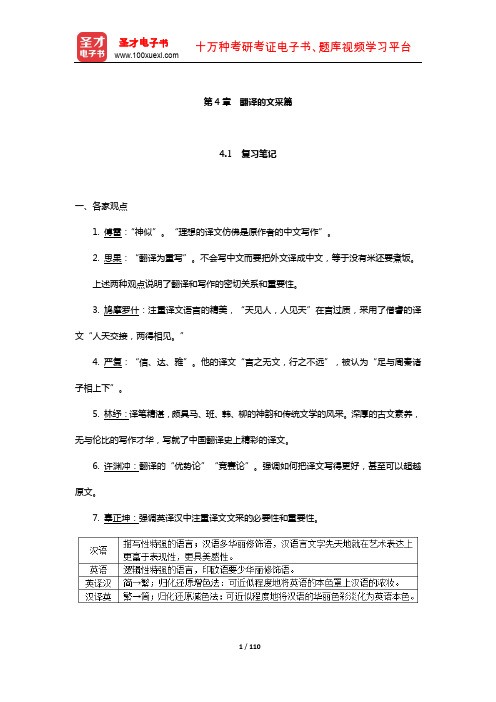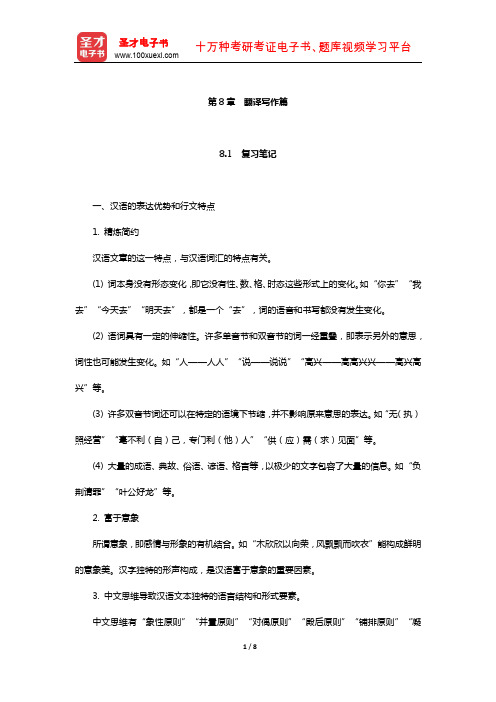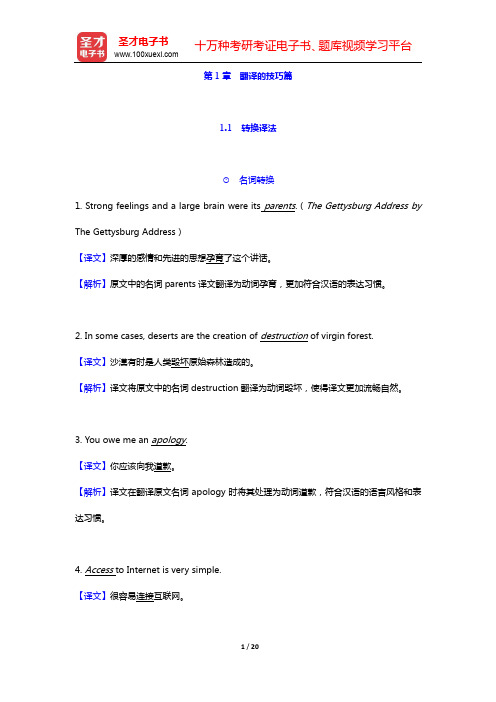英汉翻译教程
- 格式:doc
- 大小:277.00 KB
- 文档页数:56

第4章翻译的文采篇4.1 复习笔记一、各家观点1. 傅雷:“神似”。
“理想的译文仿佛是原作者的中文写作”。
2. 思果:“翻译为重写”。
不会写中文而要把外文译成中文,等于没有米还要煮饭。
上述两种观点说明了翻译和写作的密切关系和重要性。
3. 鸠摩罗什:注重译文语言的精美,“天见人,人见天”在言过质,采用了僧睿的译文“人天交接,两得相见。
”4. 严复:“信、达、雅”。
他的译文“言之无文,行之不远”,被认为“足与周秦诸子相上下”。
5. 林纾:译笔精湛,颇具马、班、韩、柳的神韵和传统文学的风采。
深厚的古文素养,无与伦比的写作才华,写就了中国翻译史上精彩的译文。
6. 许渊冲:翻译的“优势论”“竞赛论”。
强调如何把译文写得更好,甚至可以超越原文。
7. 辜正坤:强调英译汉中注重译文文采的必要性和重要性。
二、如何达到译文的文采性1. 对原文深刻的洞察理解,要体现原文的风格。
要准确、流畅地表达原文作者的思想,使读者发生兴趣,能够理解和接受。
2. 文采来自译者较高的艺术修养,即译者的文才、才华。
(1) 译者掌握各种表达方式、表现技巧的能力;(2) 译者遣词造句、修辞达意的能力;(3) 文采:译文的语言经过修饰,能切当地、艺术地表达思想感情,富有美感;(4) 文采的主要特点:艺术表达力强,具有审美效应,是增强译文感染力的重要因素。
3. 积累语言材料(1) 语言材料主要指词汇。
词汇丰富是语言丰富的一个重要标志。
有了丰富的词汇,遣词造句才能得心应手,左右逢源;提笔行文,才会随意生姿。
(2) 向优秀作品学习语言。
现代的、古代的、中国的、外国的经典作品。
精美的成语、典故、警句、妙语,都能丰富我们的语言材料,增添我们写作、翻译的文采。
4. 要善于锤炼语言(1) 分寸感:译者的语言灵敏度强,能够精细入微地辨别词义,恰如其分地运用语言。
(2) 准确:准确是文采的前提,是掌握分寸感的具体表现。
①语言准确,首先用词要求准确。
准确地区分词语的感情色彩,选用词语要褒贬恰当。

第8章翻译写作篇8.1 复习笔记一、汉语的表达优势和行文特点1. 精炼简约汉语文章的这一特点,与汉语词汇的特点有关。
(1) 词本身没有形态变化,即它没有性、数、格、时态这些形式上的变化。
如“你去”“我去”“今天去”“明天去”,都是一个“去”,词的语音和书写都没有发生变化。
(2) 语词具有一定的伸缩性。
许多单音节和双音节的词一经重叠,即表示另外的意思,词性也可能发生变化。
如“人——人人”“说——说说”“高兴——高高兴兴——高兴高兴”等。
(3) 许多双音节词还可以在特定的语境下节缩,并不影响原来意思的表达。
如“无(执)照经营”“毫不利(自)己,专门利(他)人”“供(应)需(求)见面”等。
(4) 大量的成语、典故、俗语、谚语、格言等,以极少的文字包容了大量的信息。
如“负荆请罪”“叶公好龙”等。
2. 富于意象所谓意象,即感情与形象的有机结合。
如“木欣欣以向荣,风飘飘而吹衣”能构成鲜明的意象美。
汉字独特的形声构成,是汉语富于意象的重要因素。
3. 中文思维导致汉语文本独特的语言结构和形式要素。
中文思维有“象性原则”“并置原则”“对偶原则”“殿后原则”“铺排原则”“凝练原则”和“协律原则”。
从翻译的角度看,直接对译文写作有影响的有:(1) 并置原则汉语写作中常有“叠言”“叠句”“叠章”的语言形式。
作者通过“并置”的语句,创造意象纷呈、语义丰满、语势张扬的叙述话语。
如,“诚信是……;诚信是……”,不仅有声有色地强化了文意,同时还把文意展示为一个细腻、立体的意脉网络,见出才华和文采。
(2) 对偶原则强调词性、词义的相反相成。
在写作上,最典型的就是骈体文和近体诗的写作,它们都要求对仗,并形成了严格的规范。
这种对偶句式积淀在民族文化心理结构中,在写作中我们有了上句,往往下意识地就生带出下一句来。
翻译到顺手处,译者自然也会写出这种句式。
(3) 凝练原则中国人讲究“炼字”“炼句”“炼篇”和“炼意”,讲究“推敲”,林语堂认为,汉语的单音节性“造就了极为凝练的风格”。

第1章翻译的技巧篇1.1 转换译法⊙名词转换1. Strong feelings and a large brain were its parents.(The Gettysburg Address by The Gettysburg Address)【译文】深厚的感情和先进的思想孕育了这个讲话。
【解析】原文中的名词parents译文翻译为动词孕育,更加符合汉语的表达习惯。
2. In some cases, deserts are the creation of destruction of virgin forest.【译文】沙漠有时是人类毁坏原始森林造成的。
【解析】译文将原文中的名词destruction翻译为动词毁坏,使得译文更加流畅自然。
3. You owe me an apology.【译文】你应该向我道歉。
【解析】译文在翻译原文名词apology时将其处理为动词道歉,符合汉语的语言风格和表达习惯。
4. Access to Internet is very simple.【译文】很容易连接互联网。
5. An acquaintance of world history is helpful to the study of current affairs.【译文】读一点世界史,对学习时事是有帮助的。
【解析】原文acquaintance是名词,本意为熟悉,翻译时将其处理为动词,并结合其后搭配的短语选取意思,译文将其翻译为动词读,使得整个译文符合汉语的逻辑和语言风格。
6. Repeated changes in a flow direction ensure even diffusion over the entire exit area.【译文】反复改变流动方向,可确保在整个出口域内扩散均匀。
【解析】原文名词changes翻译为动词改变,汉语表达多用动词,因此使得译文流畅自然。
7. Mozart was a great lover of music when he was a boy.【译文】莫扎特儿时酷爱音乐。

How to explain that I was not a proud owner seeking admiration for his vehicle, but a tourist who had broken down如何解释,我不是一个骄傲的主人寻求佩服他的汽车,但游客坏了吗Special equipment assures that the computers will not be disturbed by power interruptions that last less than two hours.特种设备确保计算机就不会被打断,力量持续不到两个小时。
It is actually very, very old and was not always as beautiful as it is now. It is not certain how the Earth began. Probably it began as a huge globe of gas and dust. The globe became smaller and denser. Today the outer layer or crust is cool and hard,它实际上是非常非常老的,并不总是像现在这样美丽。
这都是不确定的地球就开始了。
可能起源于一个由气体和尘埃组成的庞大球体。
地球变得更小且致密。
今天的外层或地壳是凉爽且硬,It was not anger, nor surprise, nor disapproval, not horror, nor any of the other emotions that she had been prepared for.那表情不是生气,不是惊讶,不是不满,不是嫌恶,也不是她原先准备应付的任务一种感情。
Modern geology has for its aim the deciphering of the whole evolution of the earth from the time of the earlier records that can be recognized in the rocks to the present day.当代地质解释为其目标的整体演化的地球早期的时间记录,可以识别岩石到当代。


英汉翻译教程——上海外语教育出版社1、John can be relied on. He eats no fish and plays the game.约翰为人可靠,他既忠诚又正直。
2、He who would eat the nut must first crack the shell.(前置)要吃核果,必先敲壳。
(要享受果实,必先劳动。
)3、They fought so bravely that the invasion was crushed inseventy-two hours.(后置)他们打得勇敢,七十二小时内就粉碎了敌人的入侵。
(后置)We worked fast and well, so that we overfulfilled our production plan. (后置)我们工作得又快又好,超额完成了生产计划。
(后置)4、He is the last man to come.他是最后来的。
He is the last man to do it.他是绝不会干那件事。
He is the last person for such a job.他最不配干这个工作。
He should be the last (man) to blame.怎么也不该怪他。
He is the last man to consult.根本不宜找他商量。
This is the last place where I expected to meet you.我怎么也没料到会在这个地方见到你。
5、He was a man of integrity, but unfortunately he had a certainreputation. I believe the reputation was not deserved.他是一个正直诚实的人,但不幸有某种坏名声。
我相信他这个坏名声是不该有的。
6、He had lied to me and made me the tool of his wicked deeds.他欺骗了我,使我成了进行罪恶勾当的工具。
英语翻译基础教程总主编:冯庆华主编:冯庆华陈科芳1 “意思”的译法甲:这是一点小意思,请务必收下。
乙:你这个人真是有意思,怎么也来这一套。
甲:哎,只是意思意思,乙:啊,真是不好意思。
译文:A:This is a little gift as a token of my appreciation .Please do take it . B:Oh, aren't you a bit too polite ? you should not do that .A: Well ,it just conveys my gratitude.B: Ah, thank you then ,though i really do not deserve it . 2 “说”(1)阿Q将衣服摔在地上,吐一口唾沫,说:“这毛虫”!《阿Q正传》译文:Ah Q flung his jacket on the ground ,spat ,and swore ,“hairy worm!”(2) “三个臭皮匠,合成个诸葛亮”,这就是说,群众有伟大的创造力。
《毛泽东选集》文: The old saying ,"three cobblers with their wits combined would equal Zhuge Liang the mastermind ,"simple means the masses have great creative power.(3):也不知安居乐业,最早见于什么典籍,四个字一针见血的点名了生活中的一个因果关系。
译文:I can not say in what canon the words "secure in one's home and happy in one's work" first appeared ,but that expression cuts to the core of a primary determinant in human life.3 你们偶然看见一颗花生瑟缩的长在地上,不能立刻分辨出它有没有果实,非得等到你接触到它时你才能知道。
1 英汉翻译教程 张培基
第一讲 翻译原则简介 一、教学目的:了解基本的翻译原则和翻译研究的问题 二、教学过程: 1.翻译的定义和内涵:(Definition and Connotation) Translation is an art/ science/craf
2.中国几位翻译家的理论(influential translation principles) 严复:信达雅--- faithfulness/expressiveness/elegance. The “three character guide” is regarded as a plumb-line of long standing to measure the professional level of translating.
傅雷:神似---spiritual conformity. Emphasizing the reproduction of the spirit of the flavor of the original.强调原作神韵再现。
钱钟书:化境---sublimed adaptation. Focus on the translator’s smooth and idiomatic Chinese version for the sake of the Chinese reader.
刘重德:信、达、切---faithfulness/expressiveness/closeness. 3.中国翻译史上的论争: 鲁迅:宁信而不顺---rather to be faithful than smooth。 目的:引入英文句式的表达法 梁实秋、赵景深:宁顺而不信---rather to be smooth than faithful 目的:可读性强,便于交流。 4.直译与意译: 直译---literal translation 意译:free translation 直译的例子:crocodile tears鳄鱼的眼泪; armed to the teeth武装到牙齿; chain reaction连锁反应; gentlemen’s agreement君子协定; one country, two systems 一国两制;
The three religions and the nine schools of thought 三教九流; paper tiger 纸老虎; Breath one’s last---断气; go to one’s external rest---安息; the long sleep---长眠; see Marx 见马克思; Go west 上西天; go to heaven 上天堂; blow out the candles 吹灯拔蜡 kick the bucket 蹬腿:
直译不等于死译(dead translation): 街道妇女应动员起来打扫卫生:Women in the street should be called on to do some cleaning. “In the street” should be replaced by “in the community”. 2
她一大早起床,进城,见到了她的公爹: She got up early, went to the town and saw her public father. Public father should be father in law.
意译的例子:It rains cats and dogs / at sixes and sevens /Adam’s apple 句子比较:Little fish does not eat big fish 直译:小鱼不吃大鱼 意译:胳膊拧不过大腿
试译:天有不测风云,人有旦夕祸福: 直译:Storms gather without warning in nature and bad luck befalls men overnight.
意译:The weather and human life are both unpredictable 有人说,翻译是带着镣铐跳舞(translation is like dancing in fetters); 还有人说,翻译像女人,忠实的不漂亮,漂亮的不忠实。实际上,忠实与通顺的关系是辩证关系。
5.归化与异化(domestication/adaptation or foreignization / alienation) 归化的翻译在理论上是把语言看作交际工具;在实践上,强调通俗易懂,避免多义或歧义。习惯认为,当原文与译文之间因文化差异而出现不能通达的情况时,“要用译语文化替代原语文化”即把在译语中找不到对等的外语词汇改头换面,或套用译语中与之相似的现成的表达法,把它们变成读者熟悉的译语文化形象。
归化派代表人物尤金•奈达(Eugene A. Nida): Functional Equivalence 功能对等 What is functional equivalence? “The receptors of the translated text could respond to it with comprehension and appreciation in essentially the same manner and to the same degree as the original receptors of the message”;
“Translation should arouse the same feeling in its receptors as the feeling of the readers of the original”---- Nida For instance: as white as snow 通常译为白如雪 / 但没有见过雪的人可以将其翻译为“白如白鹭毛”,以达到功能对等的目的。
Spring up like mushrooms---雨后春笋 Everybody's business is nobody's business. 三个和尚无水喝 Among the blind the one -eyed man is king. 山中无老虎,猴子称霸王 然而,翻译负有文化交流的使命,即尽可能把一个民族的语言和文化习惯介绍给另一个民族。鲁迅先生就特别强调译文要“保留原文的丰姿”。 在南京大学姜秋霞教授举办的一次翻译调查中,多数读者认为,读异国文学是为了欣赏异国作品特有的韵味和语言风格,他们在读译文之前就已经对不同文化的差异有了一定的心理准备,有些人读译文的目的之一是想了解外国人与中国人之间的异同究竟在什么地方。因此,从促进世界文化交流这个角度上讲,我们在处理英译汉或汉译英时,都应着力于全面、完整地向译语读者介绍对方(己方)的全部意蕴,包括文化。特别要强调的是,在汉译英中,我们尤其要树立这种文化意识,积 3
极创造条件,弘扬中华文化,帮助英语读者扩大加深对中华文化的了解。异化的翻译无疑在文化交流方面起了巨大的作用。
异化派代表人物韦努蒂(Lawrence Venuti ): All roads lead to Rome: 条条大道通罗马 不能译成:殊途同归 To teach one’s grandmother to eat eggs: 教老祖母吃鸡蛋 不能译成:班门弄斧 班门弄斧:show off one’s proficiency with the axe before Lu Ban, the master carpenter. Hence: Make hay while it is sunshine: 不能译成:趁热打铁 If I slapped someone, He would see the way to Cracow: 要是我给谁一巴掌,准会把他扇到克拉科去。不能:一巴掌扇到西天去。
武松要吃酒,哪里听他人发说,一转身道:“放屁!放屁!”pass your wind/sheer nonsense 6.段落翻译练习: 沿着荷塘,是一条曲折的小煤屑路。这是一条幽僻的路;白天也少人走,夜晚更加寂寞。荷塘四面,长着许多树,蓊蓊郁郁的。路的一旁,是些杨柳,和一些不知道名字的树。没有月光的晚上,这路上阴森森的,有些怕人。今晚却很好,虽然月光也还是淡淡的。
Beside the lotus pond there is a small tortuous cinder path. This is a secluded road even by day, more isolated still at night. Around the pond, there are many trees rich in leaves, lush and green. There are some willows along the path, and some trees whose names I do not know. When there is no moonlight the road and pond have a haunted disconcerting feel to them. Tonight is not bad, even though the moon looks pale.
第二讲 翻译的过程 一、教学目的:怎样去理解和表达;学会表达的基本策略。 二、教学过程: 1.理解与表达: He found them pushing needles, thread, pots, pans, ribbons, yarns, scissors and buttons to house wives.他发现他们在向家庭主妇推销针头线脑,锅碗瓢盆。 (国外没有瓢)
改为:他发现他们在向家庭主妇推销针线,锅罐,绸带,剪刀和钮扣。 Do you see any green in my eye? 你以为我是好欺骗的吗? It is an order from President Bush/ I don‟t care if it is from bush, tree, or grass. 这是布什总统的命令,管他什么布什,布头儿,布片儿,我才不在乎呢。
The old man‟s heart missed a beat when he saw the pearl. 这位老人一看到这颗珍珠高兴得连心都跳不过来。